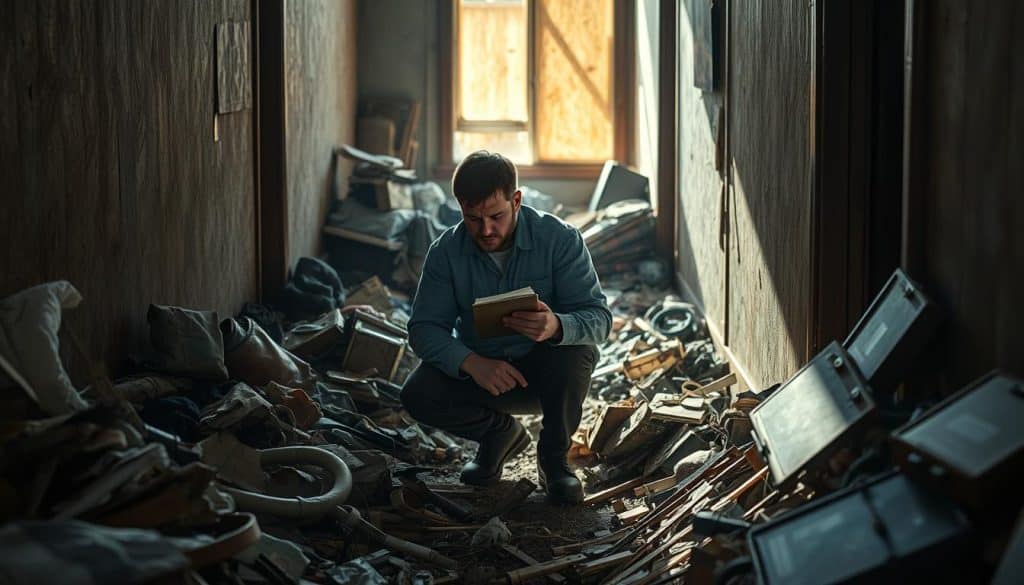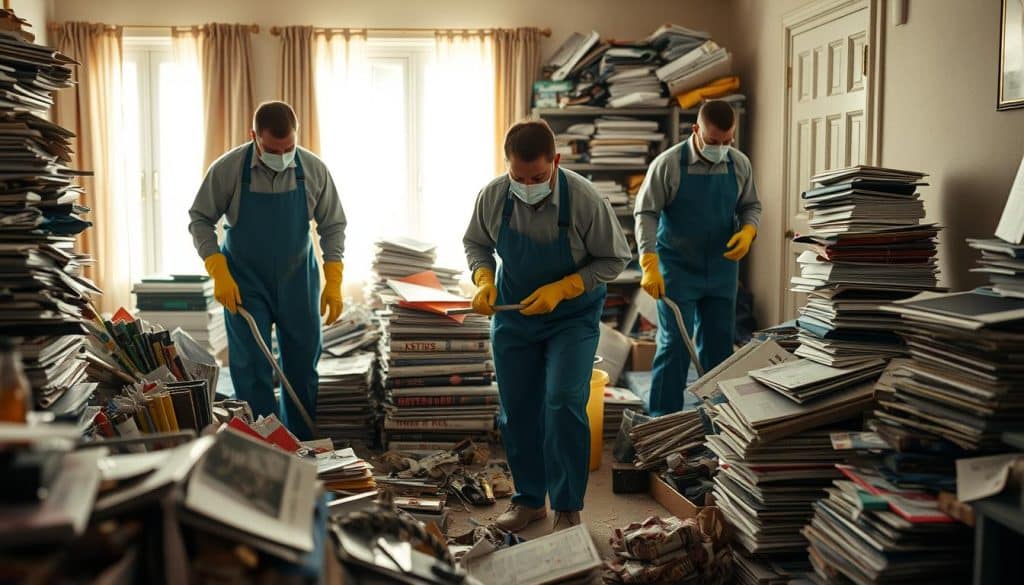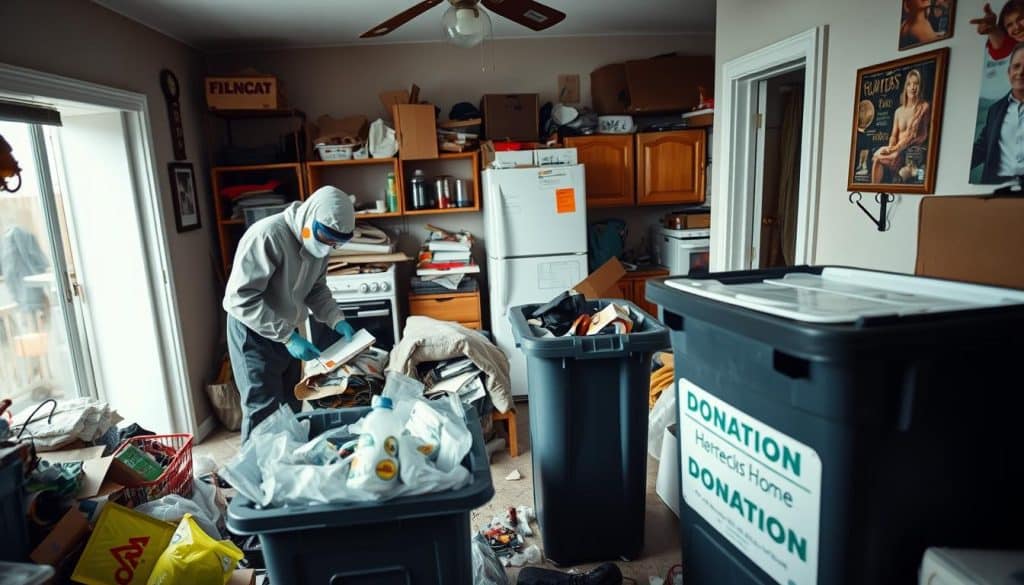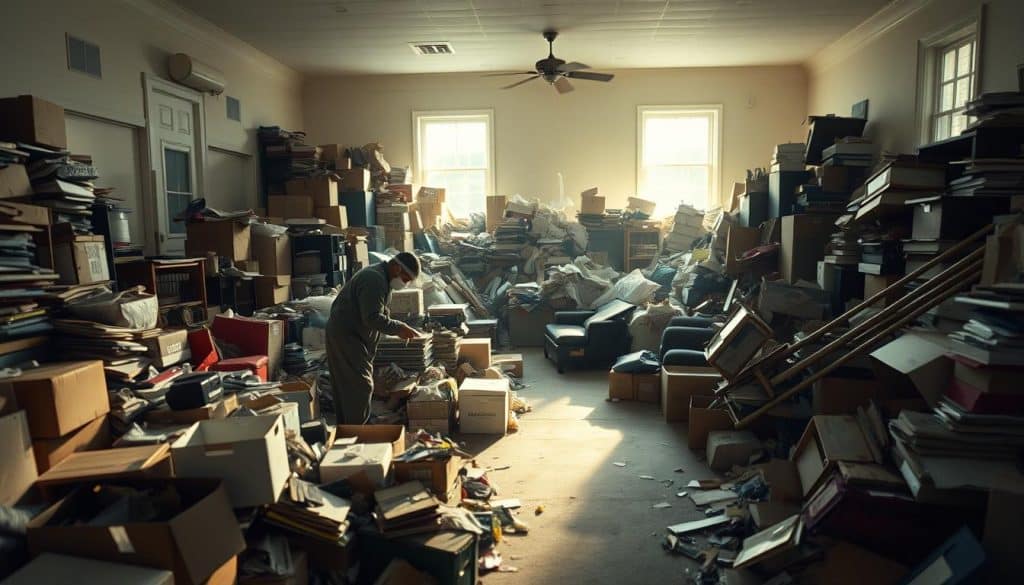Table of Contents
Ever wondered What is The Process of Hoarding Cleanup? Cleaning up hoarding is complex and very important. It needs strategies that fit each situation.
This article will explain the steps to clean up hoarding. You’ll learn how professionals turn messy places into safe homes. They start with an assessment, then deep clean, and offer ongoing support. It’s key to understand hoarding and the emotional side of it.



Key Takeaways
- Level 5 hoarding is the most severe category, indicating extreme clutter and safety risks.
- A full evaluation of the hoarding situation is essential, including identifying hazards.
- Personal protective equipment (PPE) is critical to ensure safety during cleanup efforts.
- Specialized equipment, like HEPA vacuums, is often required for effective cleaning.
- Ongoing support is vital to prevent relapse and maintain a clutter-free environment.
- Emotional challenges can arise during sorting items into different categories.
Understanding Hoarding and Its Challenges
Hoarding disorder is a tough psychological issue. It makes people keep buying things and can’t let go. This problem affects about 2-6% of adults globally. Unlike collectors, hoarders keep items that seem useless, causing clutter and unsafe living spaces.Definition of Hoarding
Hoarding is more than just clutter. People with this disorder keep 100-1,000 items they won’t throw away. This can make their homes unusable, with up to 80% of space lost. Clutter also raises fire risks by 50% because of blocked exits and flammable materials.Psychological Factors Involved
Hoarding is linked to other mental health issues. About 80-90% of hoarders also have anxiety or depression. Family history and past trauma can make it hard for them to let go. Knowing these factors helps in cleaning up and healing emotionally.Common Reactions to Hoarding
Hoarding is often stigmatized, causing shame and embarrassment. Around 60% of hoarders don’t seek help because of these feelings. Social isolation makes things worse, so it’s key for loved ones to be understanding. Understanding hoarding is the first step to helping. It lets people take back their homes and lives. For more on cleaning up, check out this link.
Initial Assessment of the Space
The first step in tackling hoarding disorder is a thorough site assessment. This lets experts see how much clutter there is. They check the living conditions and how much stuff is piled up. It’s key to spot not just the mess but also any dangers.Conducting a Site Visit
Experts on site gather important info about the living area. They note the layout and any risks. They look for things like blocked exits or mold, which are urgent to fix.Evaluating Hazards
Checking for hazards is a big part of the start. They look for mold, structural problems, and fire risks. This helps keep everyone safe and plans how to fix these issues.Communicating with the Individual
Talking to the person in a caring way is also key. They need to feel heard about their stuff. Giving emotional support and involving them in decisions helps a lot. This makes the cleanup easier for everyone.Planning the Cleanup Process
Planning well is key to a successful hoarding cleanup. A good cleanup strategy helps people deal with clutter and organize their spaces. It starts with a detailed plan that outlines steps, goals, and resources needed. Experts must consider both the physical clutter and the emotional challenges clients face. This approach creates a supportive environment for everyone involved.Developing a Comprehensive Strategy
A structured plan is essential for a good cleanup strategy. It involves assessing the situation and creating a practical yet empathetic plan. Important steps include identifying key areas, prioritizing tasks, and ensuring everyone knows their role. Adjusting the plan to fit individual needs helps everyone stay engaged and improves efficiency.Setting Realistic Timeframes
Setting realistic timeframes for the cleanup reduces stress. Professionals should base the timeline on the space’s size and clutter level. Knowing it might take more than one session helps manage time better.Discussing Budget Considerations
Financial planning is vital in hoarding cleanup. Talking about costs early ensures transparency and helps clients manage their budgets. Cleanup costs can range from $1,000 to $5,000 or more, depending on the situation. Understanding these costs helps individuals make informed decisions. This sets the stage for a successful and manageable cleanup. There are resources available to help create a plan that fits specific needs without breaking the bank.Organizing the Cleanup Team
Effective professional hoarding cleanup needs a well-organized team. It’s important to choose trained personnel who specialize in hoarding services. They must be skilled in both the physical cleanup and emotional support for those facing hoarding challenges.Choosing Trained Professionals
Choosing specialized hoarding services is key. It means hiring trained professionals who get the complexities of hoarding. They handle biohazard concerns and treat individuals with respect. Their knowledge is vital for dealing with the emotional side of hoarding.Roles and Responsibilities
Clear job roles in the cleanup team make things more efficient. Each member has specific tasks, like sorting, removing junk, or deep cleaning. This approach boosts accountability and ensures thorough support throughout the process.Importance of Compassionate Support
Compassion is essential in the cleanup process. The team must offer emotional support to individuals. Kindness and understanding create a safe space for open dialogue. This helps ease the stress of decluttering and restoring their living space.Sorting and Decluttering
Sorting and decluttering are key to managing hoarding. Using structured methods makes sorting easier. This approach helps avoid feeling overwhelmed. Decluttering methods encourage active participation. They help avoid feeling too tired to make decisions.Methodologies for Sorting Items
The “Keep-Toss-Donate” system helps sort items into clear groups. It makes deciding what to keep or discard easier. This method, along with others like the “Four-Box-Method,” helps sort belongings smoothly. It gives people a clear view of what they own.Criteria for Keeping or Discarding
Having clear rules for what to keep or discard is important. Items are judged based on their condition and usefulness. This way, people feel more confident in their choices. It leads to a more organized and tidy space.Managing Emotional Responses
Handling emotions is critical during the sorting process. Experts offer support and strategies to reduce stress. Their ongoing encouragement helps people stay strong.
Safe Removal of Items
Removing items safely during hoarding cleanup is key for everyone’s health and safety. Using the right debris removal techniques is important. It helps handle materials carefully. This part focuses on finding efficient cleanup methods that don’t disrupt much and keep the crew safe. Experts in hoarding debris removal make the process smoother and less stressful for clients.Techniques for Removing Debris
Special tools like dumpsters and bins are essential for hoarding cleanup. Trained professionals use these tools to manage a lot of clutter. They follow safe methods to avoid accidents and injuries. They also make sure the area is not damaged further and follow local laws.Disposal of Hazardous Materials
Knowing local laws about hazardous materials is important for safe disposal. Experts in biohazard cleaning use strict safety rules for dangerous stuff like mold or chemicals. They focus on protecting the environment and keeping everyone safe. They take all the right steps to handle these materials safely. Safety is a top priority, even in risky environments.Documentation and Inventory
Keeping detailed records and managing inventory is a big part of hoarding cleanup. Making an inventory of removed items helps track progress and manage resources. It’s important for being accountable and helping with insurance claims. By documenting before and after, professionals show the full extent of the work. They also keep clients informed.Deep Cleaning and Restoration
Deep cleaning is key after decluttering in hoarding cases. It means cleaning every surface, floor, and hidden spot well. This step is not just about making things look good. It also makes homes healthier by removing allergens and bacteria. It gets rid of bad smells too. A clean home is better for your health and happiness.Importance of Deep Cleaning
Deep cleaning is needed to make a home safe again. It makes the space fresh and ready for living. Homes with hoarding issues often have hidden dangers. Cleaning deeply is a must for fixing homes. It helps make sure the place is safe and organized.Addressing Mold and Water Damage
Fixing water damage and removing mold is critical for a home’s health. Experts check for moisture during cleaning. They get rid of mold to make the home safe again. Ignoring these problems can cause big structural issues. That’s why getting help from professionals is important.Restoring the Space’s Functionality
Turning cluttered spaces into useful areas is the goal. This means moving furniture and setting up systems for organization. It makes homes easier to live in. Restoring a home’s function helps families get back to normal. A clean, organized home is better for everyone’s well-being.Handling Emotional Wellbeing
It’s key to focus on emotional wellbeing when cleaning up from hoarding. Emotional support is vital in helping people through the tough parts of decluttering. Support workers should be ready to help with anxiety or stress, keeping people motivated and reassured. This approach helps build emotional strength. It also helps people deal with their attachment to things.Providing Emotional Support During Cleanup
Getting emotional support during cleanup can really help. When people face their belongings, they feel many emotions. This is when mental health support is most important. Trained professionals can help ensure people feel supported in their choices. This support helps prevent feelings of loneliness, common in hoarding.Importance of Counseling Services
Counseling services offer personalized help to understand hoarding’s psychological roots. Therapists skilled in hoarding therapy help uncover the reasons behind the behavior. This helps people find better ways to cope. It also provides ongoing help to keep spaces clean. Mental health support ensures people are tackling both their physical and emotional spaces.Building a Support Network
Building a strong support network is essential for beating hoarding. Connecting with community resources and local groups offers ongoing help and support. These networks let people share their stories and learn from others. This connection boosts motivation and helps keep progress going. Working together to build a support network increases the chance of keeping a clean, safe home.Preventing Recurrence of Hoarding
Stopping hoarding from coming back needs a mix of support and routines. It’s about ongoing checks and follow-ups that fit each person’s needs. Regular meetings help keep people on track and build new habits.Implementing Ongoing Support
Getting help from mental health experts is key for those fighting hoarding. Regular talks help spot signs of slipping back. This way, issues can be tackled early, keeping the focus on staying clean.Ways to Maintain a Clean Space
Keeping a place tidy means using good habits and strategies. Professional organizers can teach how to avoid mess. Regular cleaning helps keep spaces organized and builds lasting skills.Regular Check-Ins and Follow-Ups
Having a set time for check-ins is important. It lets people see their progress and what needs work. Support groups offer the emotional boost needed to keep going, helping to stick with positive changes.Array of Solutions: Your Partner in Cleanup
Array of Solutions has been a trusted name in hoarding cleanup for over 15 years. We offer professional services in Upstate South Carolina, including Greenville SC. Our team specializes in personalized solutions, ensuring safety and compassion.Overview of Our Services
We provide junk removal, deep cleaning, and remediation for hoarding. With over 15 years of experience, we handle all levels of hoarding. We address health risks like mold and pest infestations, tailoring our approach to your needs.Our Areas of Operation
We serve many locations in Upstate South Carolina, including Simpsonville and Spartanburg. Greer, Pickens, Easley, Clemson, Taylors, and Travelers Rest are also part of our service area. You can rely on us for prompt and effective hoarding cleanup.Contact Information
For immediate help, call Array of Solutions at (864) 710-6413 or email scmoldremoval@gmail.com. Our team is ready 24/7 to assist you with a personalized touch.Why Choose Array of Solutions for Hoarding Cleanup?
Array of Solutions puts your satisfaction first. We offer top-notch service and reliable support for hoarding cleanup. Our team is dedicated to meeting your needs with a plan that fits your situation. Whether it’s dealing with too many items or getting ready for mold removal, we handle it with care. We make sure each client gets the attention they deserve.Commitment to Customer Satisfaction
We do more than just clean up. We solve the root problems like water damage and mold. Our certified team is ready to provide the best service for you. With us, you can count on a safe and healthy home. We focus on quality to ensure your peace of mind.Comprehensive Mold and Water Damage Services
Hoarding can cause serious problems like mold and water damage. Our services are key to fixing these issues. We know how to clean up efficiently and effectively. Our team is ready for any challenge. We make sure your home is safe and comfortable again.Expertise and Experience in the Field
Array of Solutions has years of experience in hoarding cleanup. We combine our knowledge with care to help you. Our certified solutions tackle the tough parts of cleanup. Choosing us means you’re choosing a partner who cares about your health. We aim for lasting changes in your home.
FAQ
What are the signs of hoarding disorder?
Signs include a lot of clutter and trouble throwing things away. Spaces may be unsafe or dirty. People with hoarding disorder often feel very attached to items others see as worthless.
How long does the hoarding cleanup process take?
Cleanup time varies based on how much clutter there is. It can take a few days to weeks.
Is it safe to clean a hoarding environment?
Yes, but safety is key. Use trained professionals for safe cleanup. They have the right tools and handle biohazards if needed.
How can I support someone with a hoarding disorder?
Be supportive and understanding. Encourage them to get professional help. Let them know you’re there without judging as they clean up.
What happens to the items that are discarded during cleanup?
Items are sorted into keep, donate, recycle, or discard piles. Discarded items are thrown away according to local rules. This includes safe handling of hazardous materials.
Will the individual in need of cleanup be involved in the process?
Yes, their involvement is key. Sorting and decision-making are done with care. This helps them feel empowered during the cleanup.
Can counseling help with hoarding disorder?
Absolutely. Counseling can help tackle underlying issues. It offers strategies to manage emotions and prevent hoarding in the future.
What services does Array of Solutions offer?
Array of Solutions provides hoarding cleanup, clutter removal, and biohazard remediation. We also handle mold and water damage. Our services are tailored to meet individual needs.
What areas do Array of Solutions service?
We serve many areas in South Carolina. This includes Greenville, Spartanburg, Greer, Pickens, Easley, Clemson, Taylors, and Travelers Rest.
How do I get in touch with Array of Solutions?
Call us at (864) 710-6413 or email scmoldremoval@gmail.com. We’re ready to help 24/7 with your hoarding cleanup needs.

